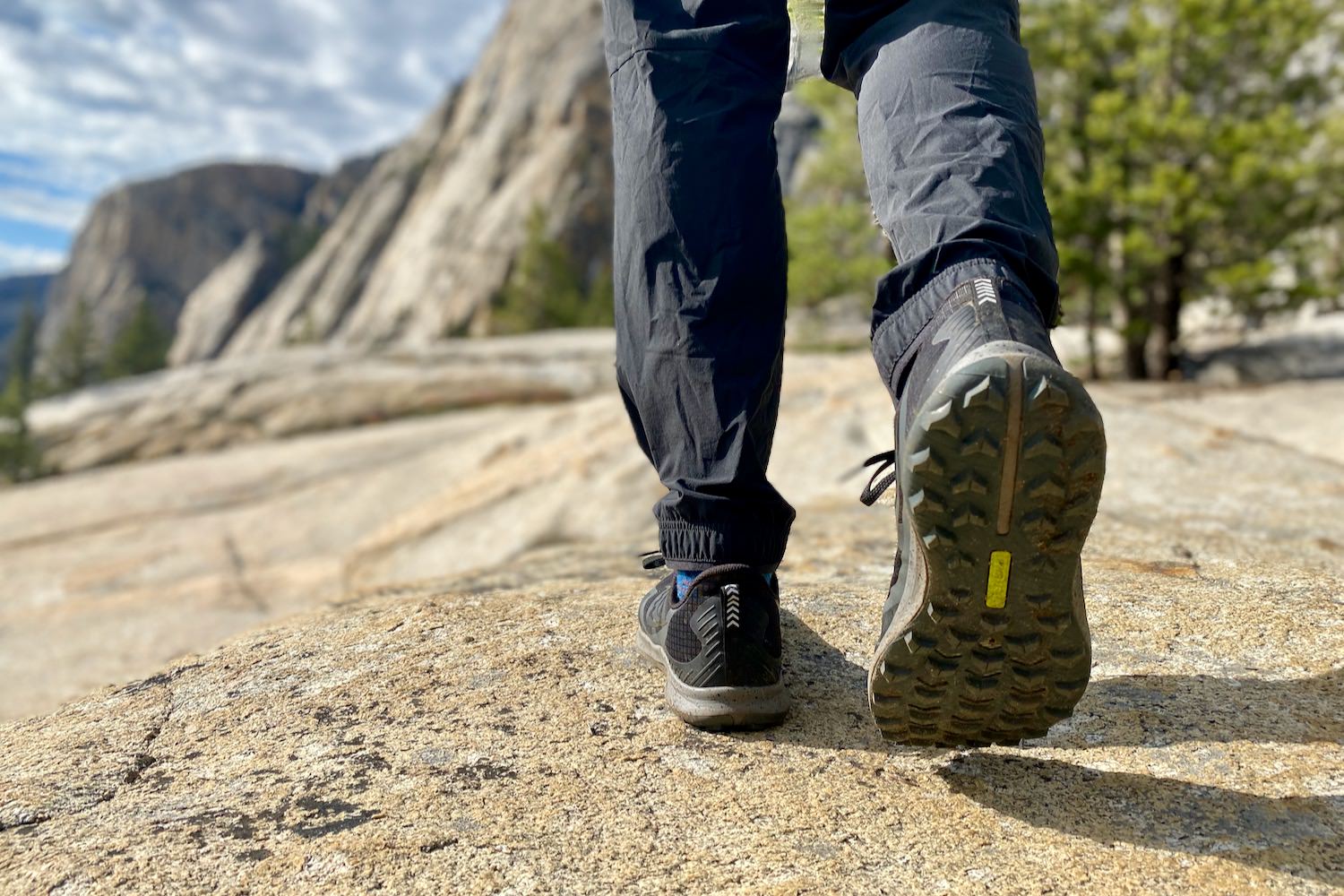
Choosing the right pair of hiking boots or shoes can be overwhelming – there are a lot of options for your feet.
When considering any hiking boot, the soles are one of the most important elements to understand. Tread patterns, materials, and design can define your performance, safety, and comfort in the backcountry. Hiking boot soles are more than just the rubbery parts under your feet – they’re the difference between an enjoyable outing and serious foot pain.
Whether your adventures take you through rugged landscapes, sandy paths, snowy summits, or muddy forests, the bottom of your shoes matter. In this guide, we explain how different tread patterns are designed for different terrains and help you choose the best shoe for your next hike.
The Basics of Hiking Boot Soles
THE SOLE’S ROLE
Your hiking boot sole is the interface between your feet and the trail. It prevents injury to your foot from sharp rocks, branches, and other hiking hazards. The soles provide crucial support by distributing your weight evenly across the foot to avoid pressure points, reduce discomfort, and keep you balanced. An efficient sole design can even conserve your energy: by keeping you comfortable and stable through challenging terrain, you’re less prone to fatigue during long hikes.
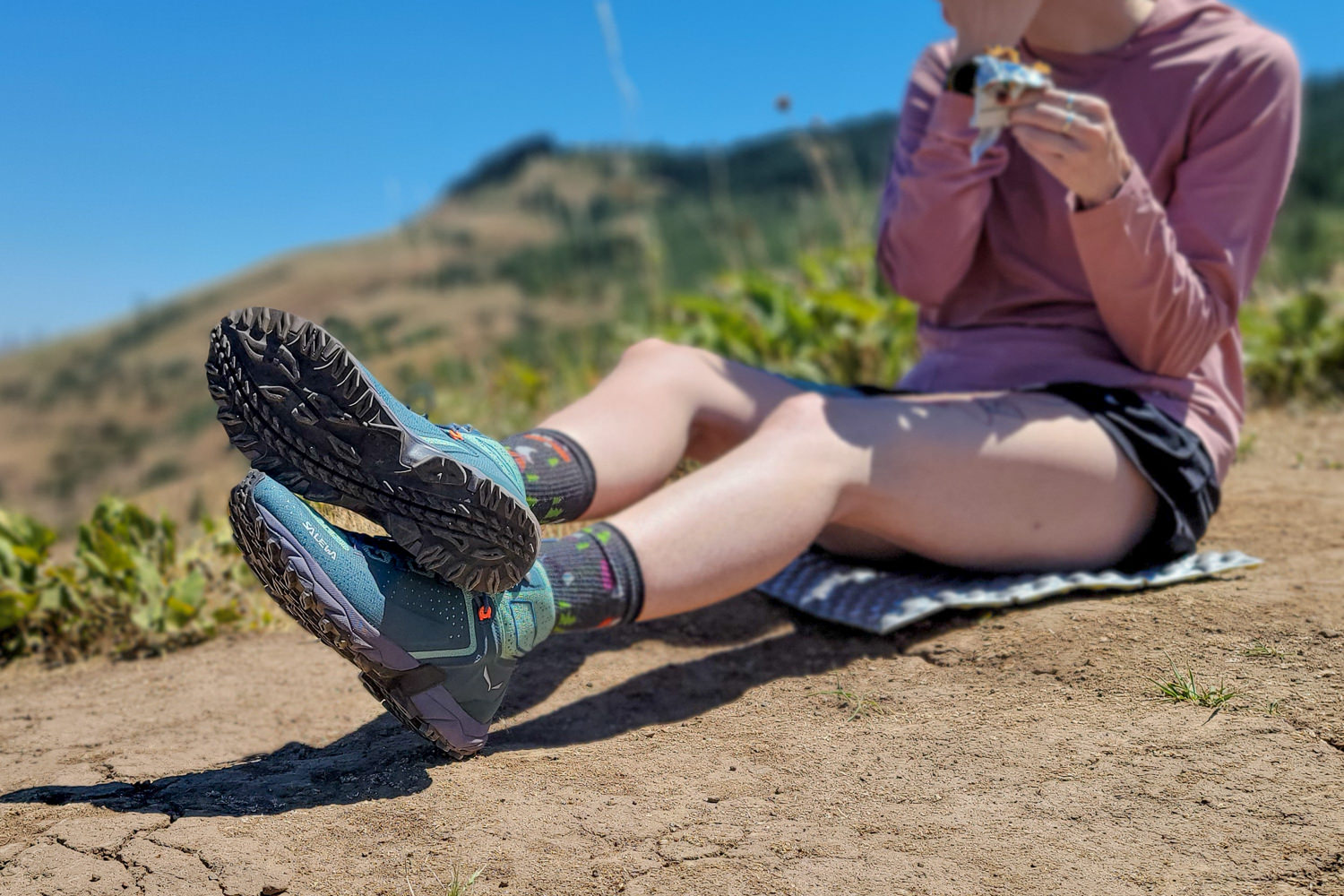
HOW HIKING BOOTS ARE BUILT
Hiking shoes are divided into two parts: the upper, and the sole. The upper of a hiking boot is the part that covers the sides and top of your foot, and in some cases, it can extend to the ankle.
The soles are the base of the shoe and are divided into three layers:
Outsole – The outsole is the visible part of the shoe on the bottom, where the knobs of the tread touch the ground. This layer is typically made of specialized rubber blends and determines how flexible or stiff the entire sole will be. The outsole is lined with lugs in a certain pattern, which determines traction, grip, stability, and durability while hiking.
Midsole – The midsole is sandwiched between the insole and outsole, and is usually constructed of firm, processed foam, soft rubber, and plastic blends, but can also be made of gels or filled with air for extra comfort. The midsole is the primary cushioning layer, vital for absorbing impacts while keeping you balanced. It’s also responsible for how light or heavy the shoe is. For example, a trail runner’s midsole is lighter because it’s usually filled with foam for nimble movement. Conversely, mountaineering boots use heavier, insulating foam for stability and warmth. The midsole can also help with temperature control since breathable materials can increase airflow and help the upper shoe eliminate sweat.
Insole – The insole is also known as the footbed. This is the part your foot touches directly. This thin layer is usually made of a hybrid textile material and adds cushioning and support on top of the midsole. The insole can also help keep your feel just a little less sweaty.
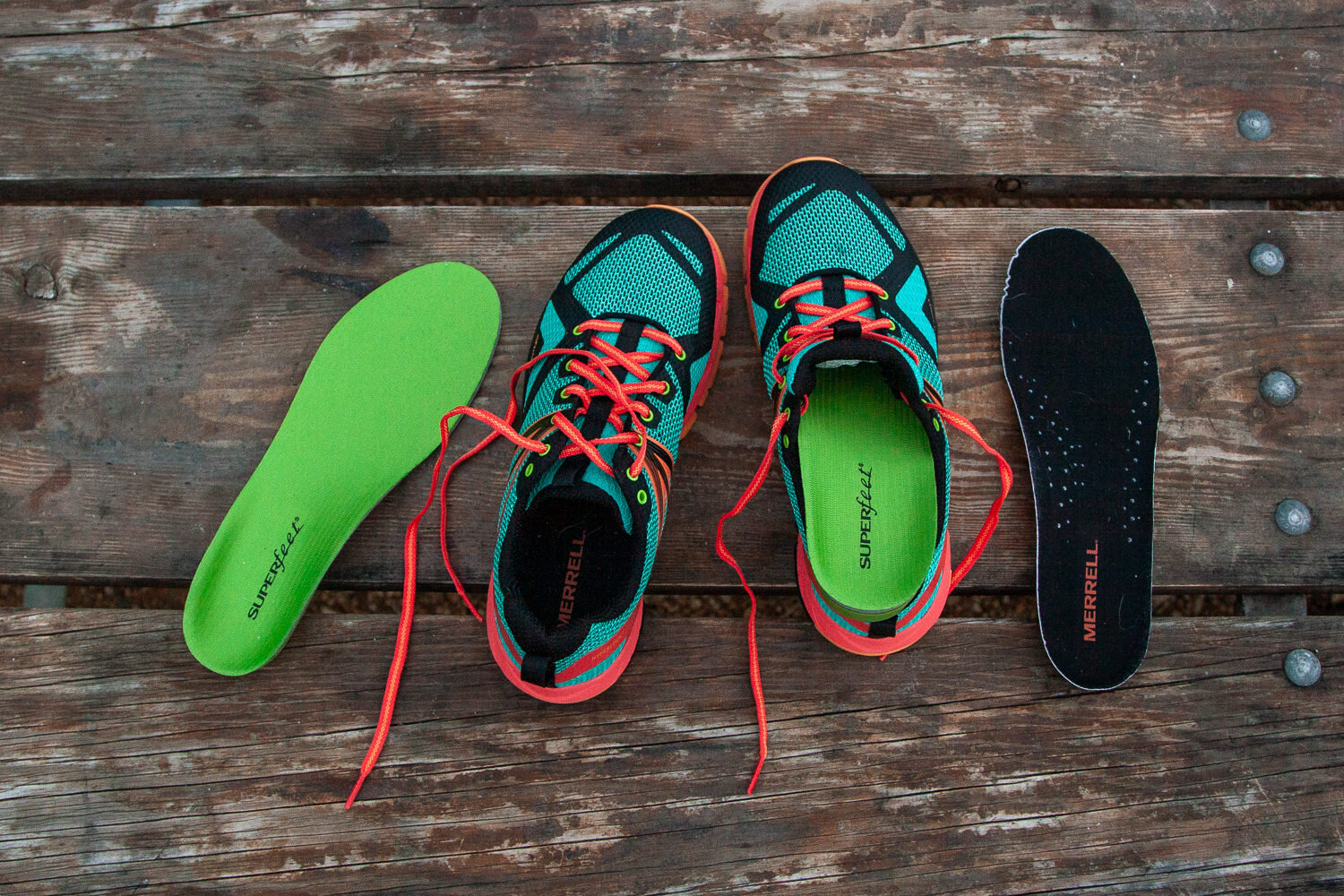
GRIP & TRACTION
Grip is a way to describe how well a hiking sole maintains contact with the ground. The more contact your shoe has with the ground, the less likely you are to misstep or fall. A good grip lets you hike with control in every step.
Traction is how effectively a hiking sole resists slipping. It’s the result of the sole’s design – like lug shape and positioning, the flexibility of the outsole, and its overall shape – interacting with the surface of the ground. A sole with outstanding traction will bite into an incline to prevent slippage.
The right pattern and lug combination are what give your soles grip and traction. A shoe with both will help you crush steep ascents or descents, stay agile through jagged trails, and move confidently on wet routes.
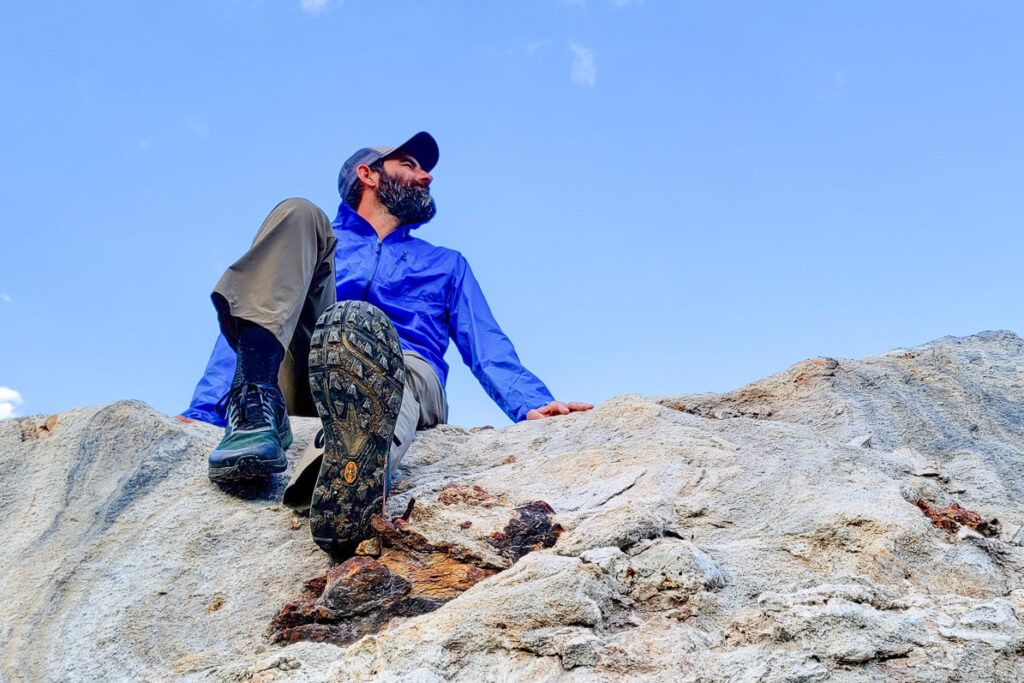
SHOES FOR YOUR TERRAIN
Hiking in different terrains poses unique risks. In a muddy place, you might be prone to slipping and falling. In a dry, desert climate, you might be prone to blisters from hot feet. Consider the time of year and current conditions of your hiking destination: can your shoe withstand extended exposure to snow, mud, extreme temperatures, and water? Understanding the terrain, weather, and circumstances where you’re going is essential. Choosing the right shoes for your environment is safer, more comfortable, and increases the chances you’ll get where you’re going, and arrive in a good mood.
That’s why hiking footwear is designed with terrain-specific features. For example, hiking boots meant for rocky terrain often feature protective toe caps, ankle protection, and aggressive lugs, whereas shoes developed for wetter places have waterproof linings, flexible soles, and more intricate tread patterns. You might be hiking in a location with many drastically different conditions, so look for a boot designed to handle it all. Just like you wouldn’t take a Prius on a 4WD road, or an ATV on a highway, your hiking shoe should match the landscape where you’re playing.
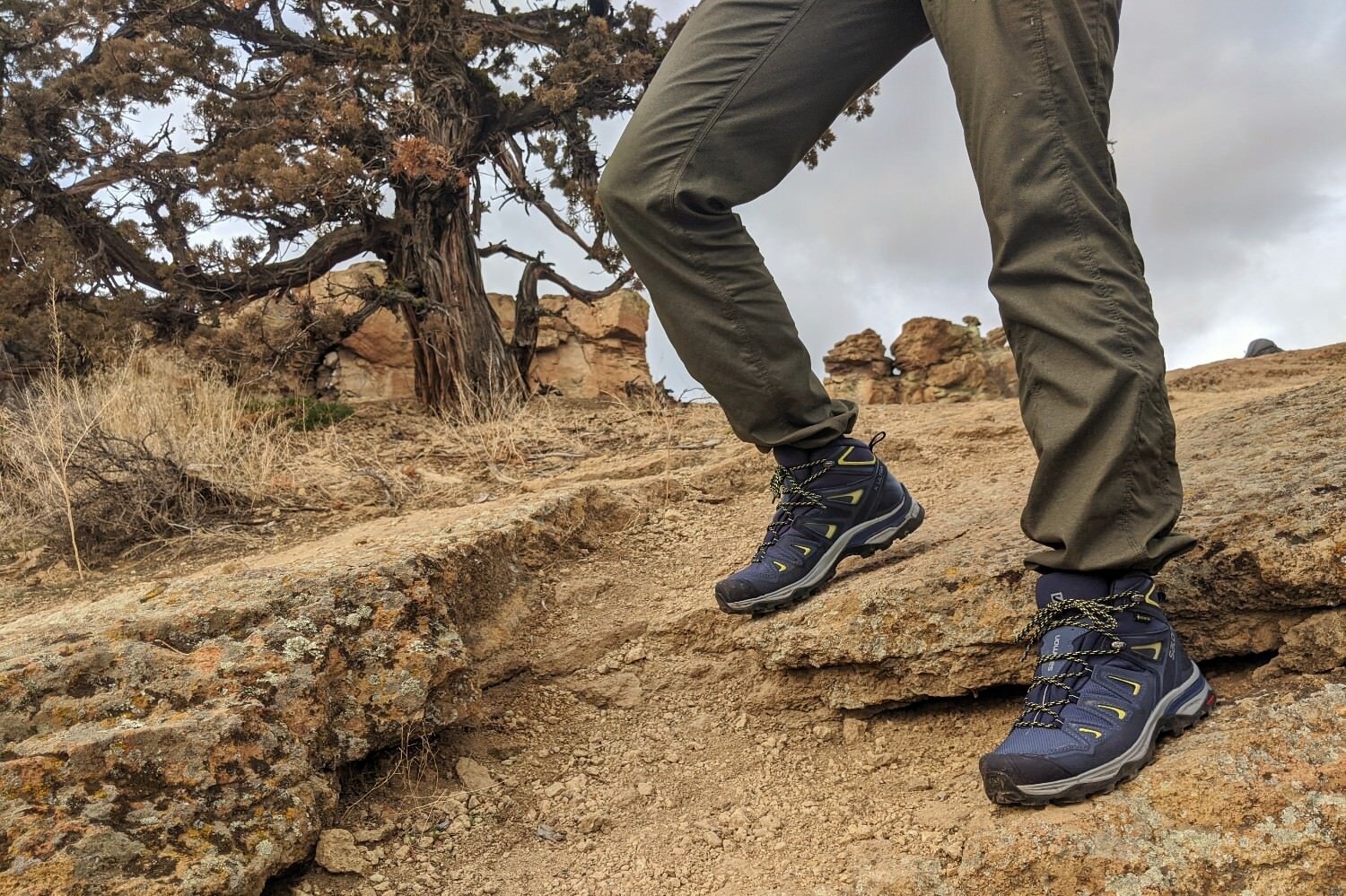
Brands of Hiking Boot Soles
Just a handful of brands are responsible for most of the outsoles and midsoles you’ll find in your footwear:
Vibram – Vibram has become a juggernaut in the outdoor footwear sole industry over the last 90+ years because of its collaborations with dozens of companies around the world. They’ve had a hand (or…foot?) in co-creating some of the most popular and durable soles and shoes in modern history. Vibram soles are widely known for innovative lug patterns and custom rubber compounds built around specific and varied terrains.
These days, you’ll find Vibram soles on everything from sandals and lightweight trail runners to burly hiking shoes and rugged mountaineering boots. The list of brands that Vibram supplies is too long to list here, but some household names include La Sportiva, Nike, and Merrell. Check out their full list of partnerships.
Michelin – Yes, the car tire company – also works with hiking boot brands to create high-performance outsoles. Michelin soles feature a unique rubber compound and tread pattern inspired by their first love: tire technology. These soles specialize in grip for wet, rocky, and muddy surfaces. Salewa, Garmont, and Arc’teryx use Michelin rubber blends on hiking boots, approach shoes, and mountaineering boots.
Gore-Tex – This well-known name is associated more with waterproof and breathable materials than boot soles. But so many hiking brands utilize their membranes, we’d be remiss not to include the brand. Gore-Tex tech uses a microporous membrane with pores smaller than water droplets, but larger than water vapor molecules. When used in shoes, this means sweat can dissipate while preventing water from entering, making them optimal for shoes and boots used in wet, muddy, and snowy conditions.
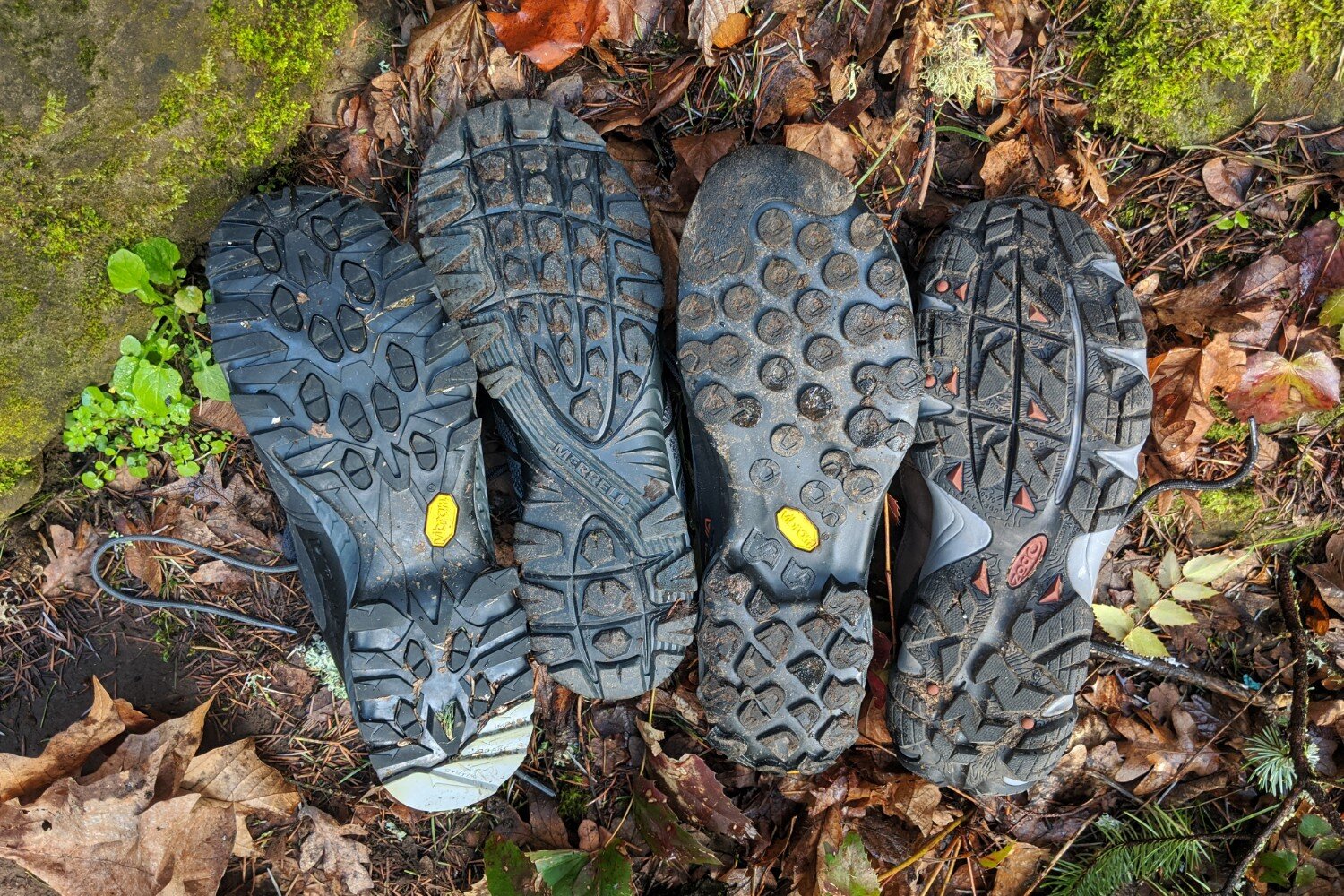
Boot Brands with Their Own Soles
Many of the most popular and renowned hiking footwear companies make their own branded hiking soles. Each sole has its own name, specific blend of rubber and foam, a niche terrain or use, and unique marketing. Keep in mind that because these companies produce their own rubber blends, these products often come at a higher price tag. Depending on the blend, many boots and shoes can require long break-in periods. And, products are often designed to have specific uses that may be too niche for a casual hiker.
Here are a few popular shoe brands with custom soles that are specific to their brand:
Impact Brake System, La Sportiva – La Sportiva got its start as a climbing company but has developed popular, unique soles for its hiking and mountaineering footwear. Its soles offer excellent traction, comfort, and precision for discerning hikers. The Impact Brake System is a tread design that uses stiff rubber on the edges of the sole, and often stickier, softer rubber on the center, to help with grip on both steep ascents and loose descents.
Contagrip, Salomon – Solomon is known for building versatile, durable hiking footwear. The company’s proprietary sole design is known as Contagrip. It is comprised of five different rubber blend and lug pattern combinations, each designed for a specific use: road, all-terrain, mud, winter, and water. Contagrip offers industry-leading traction and effective composite blends, and Solomon uses these outsole designs on everything from light trail runners to their winter boots. The Men’s Salomon X Ultra 4 GTX and Men’s Salomon Quest 4 GTX are some of our favorites. Notably, both boots feature Contagrip outsoles.
Omni-Grip, Columbia Sportswear – Columbia’s brand of rubber is called Omni-Grip. It’s designed as an all-terrain tread and rubber blend for elevated performance in wet or dry conditions and all landscapes from rock to dirt. It’s a general-use traction system for versatility in cross-country, multi-zone adventures. Omni-Grip helps make Columbia shoes feel comfortable and stable in most landscapes. Both the Columbia Fairbanks Omni-Heat and Columbia Minx Shorty 3 feature Omni-Grip outsoles, and they are one of our favorites on our best-of gear lists for both men and women.
Granite Peak & Sawtooth, Oboz – Oboz are renowned for their comfort and support. The Granite Peak and Sawtooth outsoles share their names with the shoes they’re used on. This tread design and rubber composite is not only made for durability and grip on a wide variety of terrain but it’s also very supportive.
M Select Grip, Merrell – Merrell’s soles are called M Select, but this branding covers a wide variety of their products including clothes and footwear. There are specific and different M Select designs used in their flexible trail runners and waterproof footwear that are tailored for wet, muddy, and icy terrain. Merrell regularly collaborates with Vibram and Gore-Tex on their shoes.
Elika Rubber, Lowa – Lowa boots use a mix of proprietary rubber composites and Vibram for the tread on their hiking boots. Lowa is a leader in hiking footwear for everything from mellow day hikes to multi-day mountaineering adventures. Elika rubber shows up primarily on their all-terrain models and offers a geometric lug design to make their boot soles tacky, durable, and stable for wet or dry conditions.
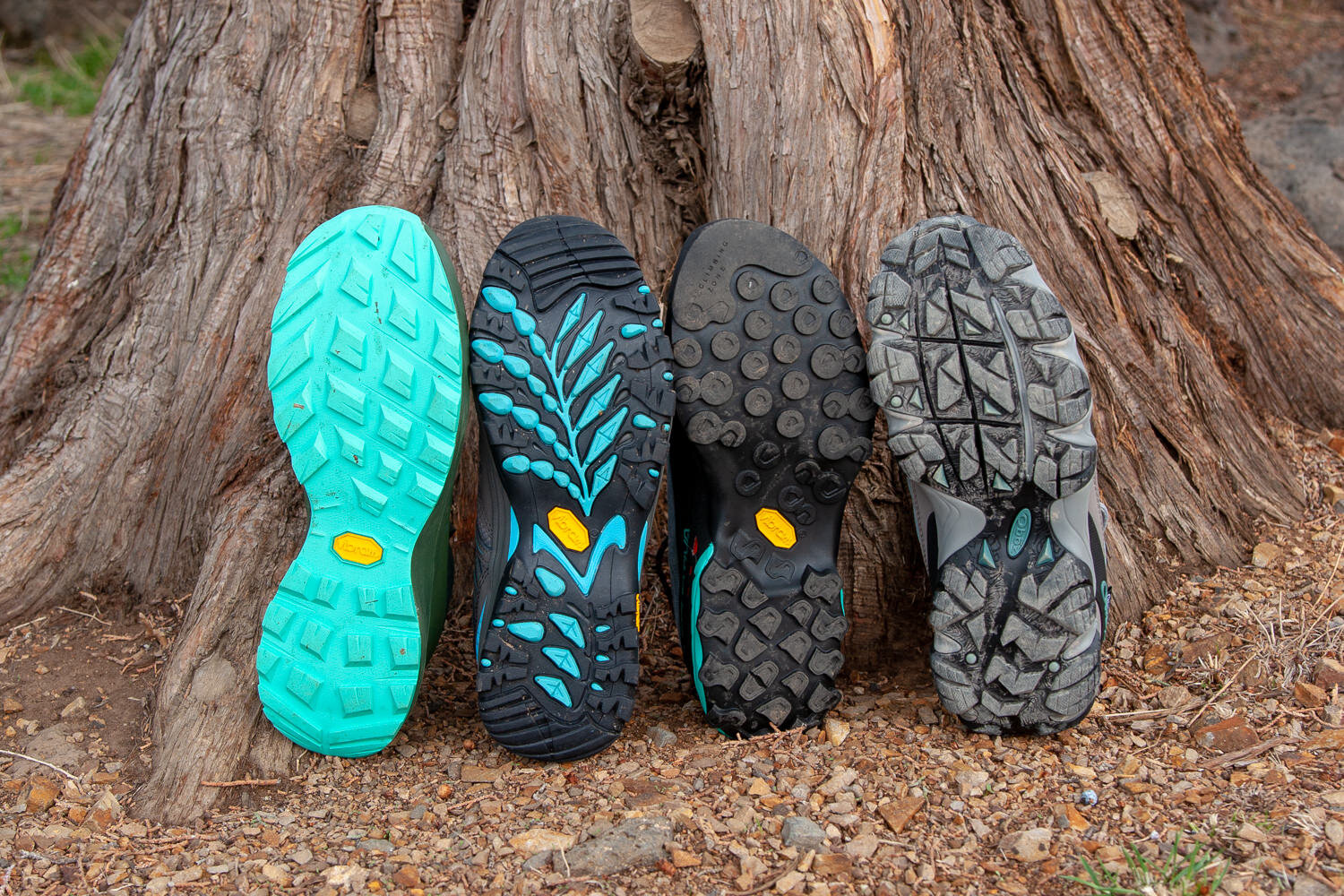
Factors to Consider When Choosing Hiking Boot Soles
FLEXIBILITY VS. STIFFNESS
Choosing between flexibility and stiffness in your next pair of hiking shoe soles is based on where you’re traveling, but it also comes down to personal preference.
You might lean towards more flexible and stickier soles if you’re covering lots of miles on maintained trails with gentle to medium slopes. In general, flexible and softer rubber compounds provide better traction on different surfaces. Rigid soles still provide excellent traction, but often the rubber is less flexible and less sticky in favor of durability and support.
Flexibility is:
- Good for hikers with smaller pack loads and a lower body weight. For example, experienced ultralight backpackers tend to prefer softer soles like those in flexible hiking shoes and trail runners, since they are generally more comfortable for long-distance hiking. It’s very rare to meet a thru-hiker hiking in stiff boots. Flexible soles use more foam and less rubber composite, so they tend to be lighter.
- If you value agility, less break-in time, and prefer trail running or fast hiking, flexible hiking shoes like trail runners can offer the speed you’re looking for.
- Bad for hikers who need more support and stability since flexible soles are not as effective with a heavy backpack. Soft soles can lead to foot fatigue and injury. Flexible soles are also less durable in rough conditions. Soft rubber and foam means faster wear and tear.
A stiffer sole is generally better for technical hiking and mountaineering, where your feet endure steep slopes and rugged terrain.
- Good for larger body types and heavier backpacking loads, a firm sole can offer more support and stability on irregular ground. Consider that hiking boots with stiffer soles often come with higher, more robust ankle support, which can help prevent sprains and injury. Because rigid soles are built with stronger materials, they better protect against rocks and roots.
- Highly technical climbing shoes and serious mountaineering boots have stiffer soles for superior edge support, high performance on steep inclines, and durability in harsh conditions.
- Stiff soles can have a long break-in period, leading to blisters and foot pain, especially on long hikes or flat trails. Stiff soles also limit agility. They tend to be heavier and limit the natural flexibility of the ankle and toes.
Unless you spend the majority of your hiking time in a specific type of terrain, a shoe with a sole that strikes a balance between flexibility and stiffness is what most people are looking for. For our top recommendations, check out our lists of Best Hiking Boots and Best Hiking Shoes.
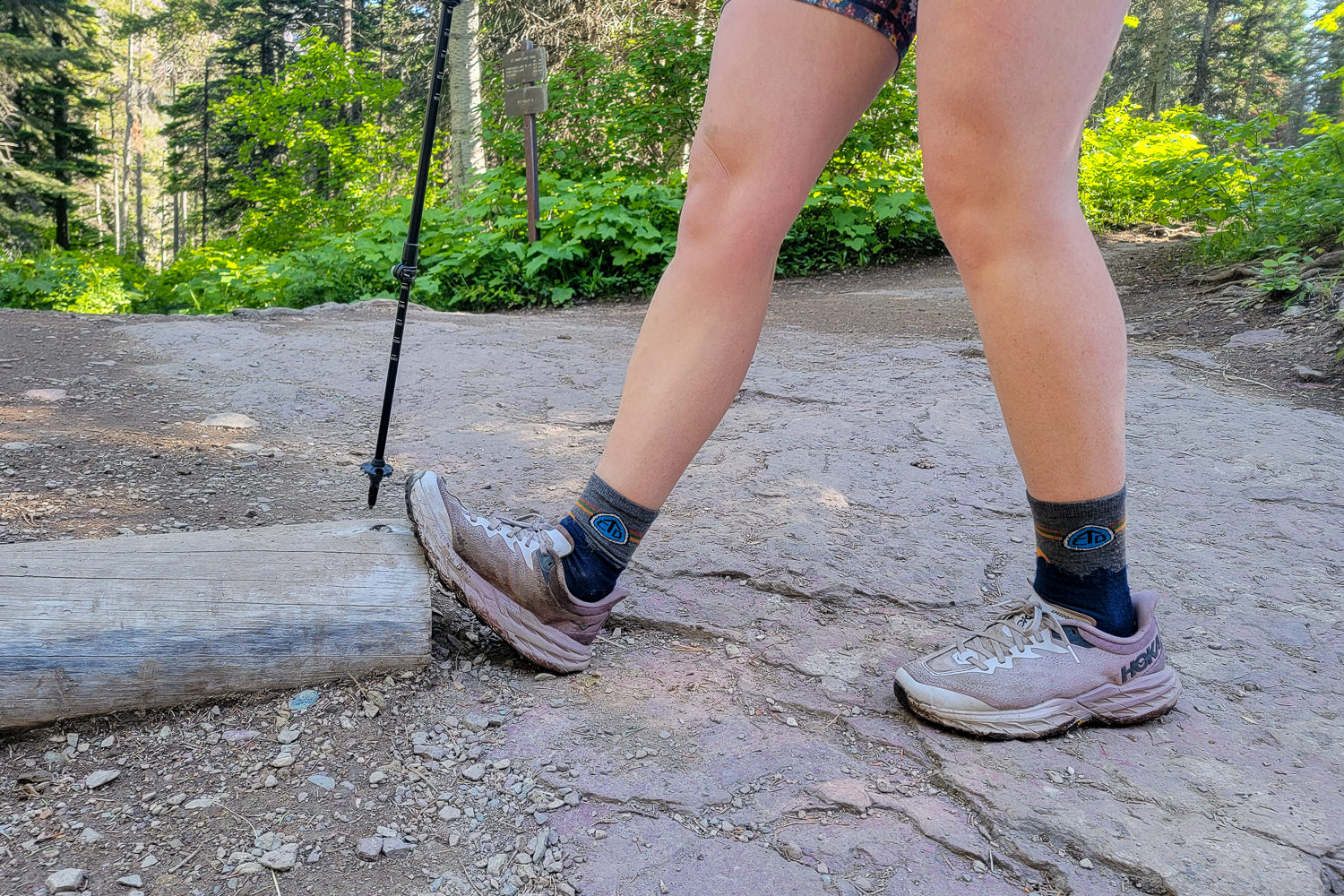
LUG PATTERN
Lugs are the raised, protruding bumps that make up the pattern on your hiking sole. They come in all shapes and depths. The right pattern and lug combination can help you tackle challenging ascents or descents, jagged and rocky trails, or wet and slick routes with ease. For muddy and wet areas, lug patterns are often designed to be self-cleaning. These are tread designs that direct water away from the shoe and shed mud and gravel as you walk to maximize grip. A smart lug pattern also distributes weight evenly, so pressure is applied to many lugs at once.
Designers strategically arrange lugs, grooves, and ridges on the outsole of your shoe to give you a wide contact area to grip the ground, or to help the shoe thrive on specific terrains. For example, a spaced hexagonal pattern with rectangular lugs in opposing directions can grip well at multiple angles, making it the preferred tread for gravelly, bumpy trails.
MATERIAL OF THE SOLE
The rubber compound of hiking outsoles defines how grippy and flexible they are, but other materials are used in the midsole. Many hiking shoes use EVA foam, an airy material that provides cushioning, shock absorption, sole flexibility, and fast movement for longer hikes. Often, mid-weight hiking shoes use polyurethane in the midsoles for a firm but comfortable structure, perfect for carrying heavy loads. For freezing weather, specialized insulated materials are used in the sole to help trap heat and keep your feet warm in snowy conditions, while releasing moisture for breathability.
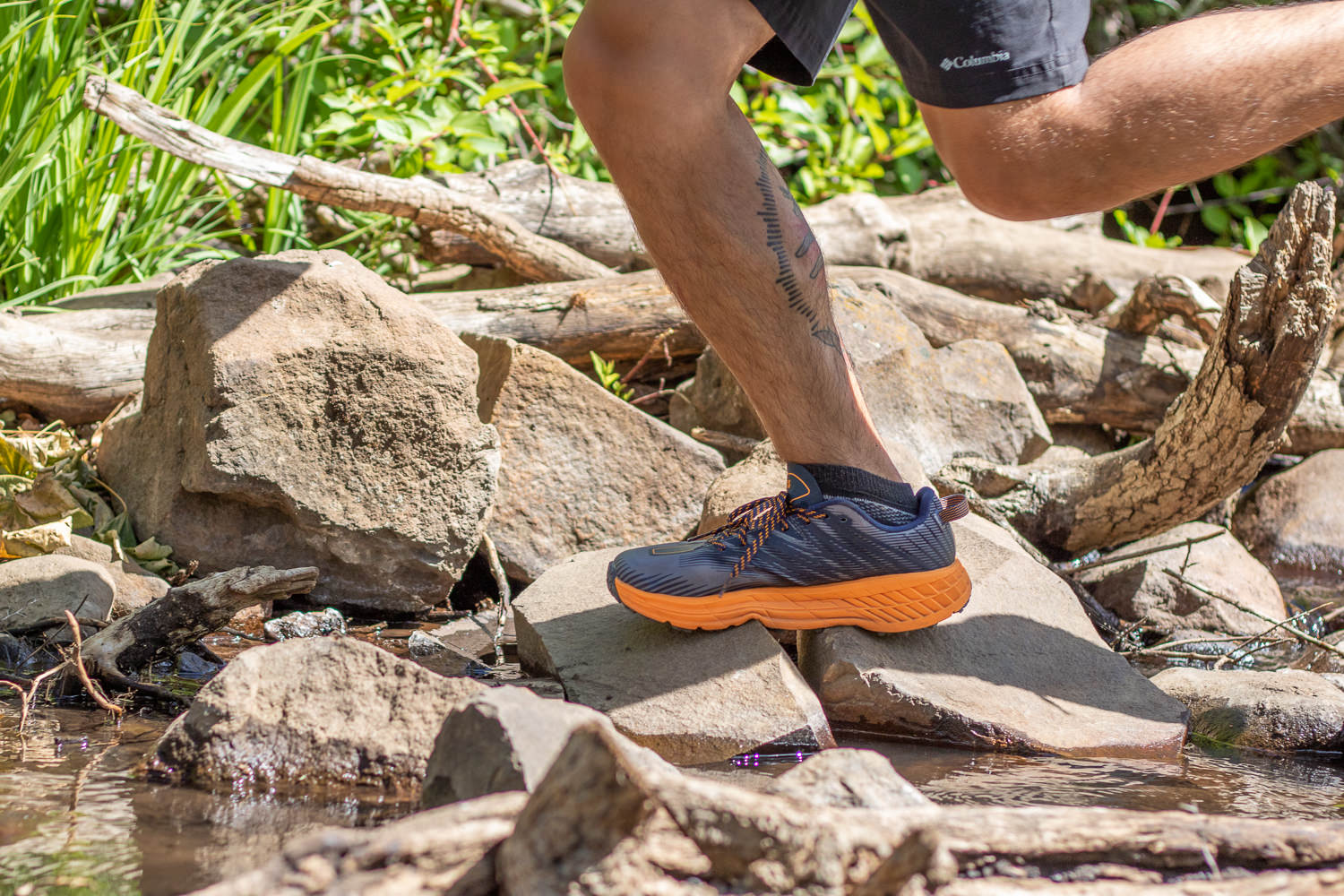
CUSHIONING & SUPPORT
An uncomfortable hiking shoe can ruin the day. Finding the right balance of cushioning and support will help you focus on your hike and not your feet. However, no hiking shoes or boots will feel amazing out of the box. Most require a break-in period. The stiffer and more supportive the sole is, the longer it will take to soften and loosen around your foot. To find the most comfortable and supportive shoes we’ve tried, take a look at our Top Picks for Hiking Boots and Hiking Shoes.
The midsole is responsible for cushioning and comfort. It absorbs shock and reduces impact on your feet to prevent issues like bruising, soreness, and fatigue. With the right level of firmness and cushioning in the midsole, your shoes will not only improve your posture, but reduce stress across major joints like hips, knees, and ankles. This is super important over long distances and for hiking on hard surfaces. Comfort also means dry feet, so don’t sacrifice breathability – ventilation is as important as cushioning to stay comfortable.
It’s equally important to find the right footwear with enough ankle, arch, and heel support. Without the right foot support, you’re prone to injury, chronic pain, or issues like plantar fasciitis. If you’re concerned about comfort and support, choose a hiking shoe with a removable footbed and use insoles that work for your specific arch height and foot shape. Heels that allow proper alignment and a good fit are also crucial: your heels should be cupped snugly and not slipping out of place. Finally, consider how much weight you’ll be carrying on the hike. The heavier your backpack, the more foot support you’ll likely need.
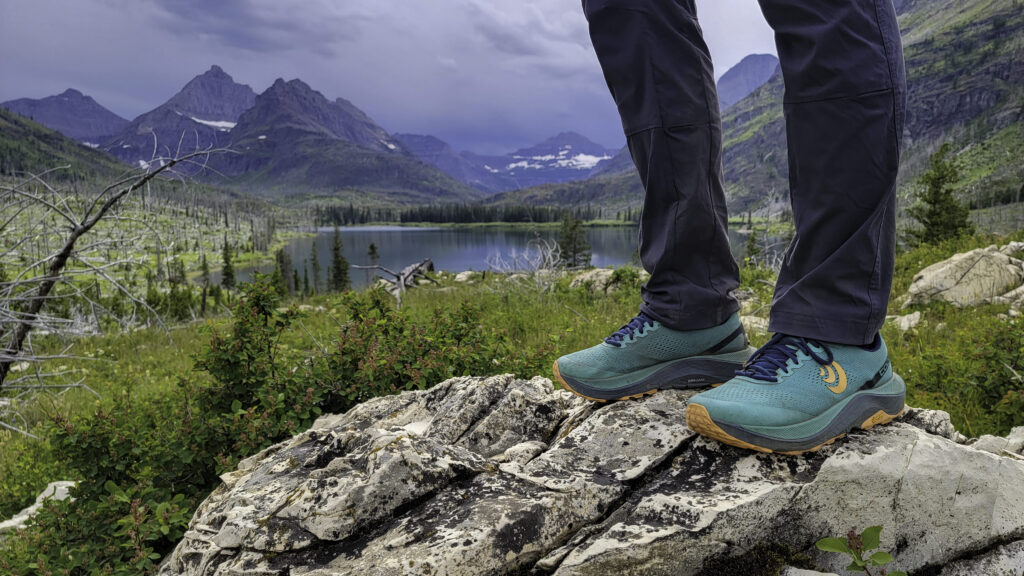
Matching Soles & Shoes for Terrain
Matching hiking boot soles to specific hiking conditions like terrain, weather, and route challenges can be confusing. However, it’s crucial to consider your environment when you’re looking for the right hiking shoes.
ROCKY TERRAIN
For rocky terrain, opt for durable, semi-stiff, and supportive hiking shoes with excellent traction to navigate loose and uneven surfaces. Vibram (or other well-built rubber soles) with aggressive, multidirectional lug patterns will give you a strong grip on unpredictable, sharp rocks.
Look for additional features like toe caps, rock plates, and ankle coverage for added full-foot protection. In rocky terrain, we recommend:
- Lowa Renegade GTX (Men’s / Women’s) – The Renegades can easily handle miles of rock. We found they are capable, versatile hiking boots that strike an impressive balance between comfort, durability, and flexibility.
- Oboz Firebrand II BDry (Men’s / Women’s) – If you’re looking for maximum support, you’ve found it. The Firebrand is a rugged hiking shoe with burly traction and offers intense stability and durability for cruising through talus fields and bumpy hikes.
- Vasque St. Elias GTX (Men’s / Women’s) – The St. Elias uses a Gore-Tex liner paired with a stiff Vibram sole with a trustworthy lug pattern. This model is perfectly suited to rocky terrain, and its tough leather upper will easily handle the sharp edges of talus and scree fields and the sole has enough flexibility to handle different angles and surface areas.
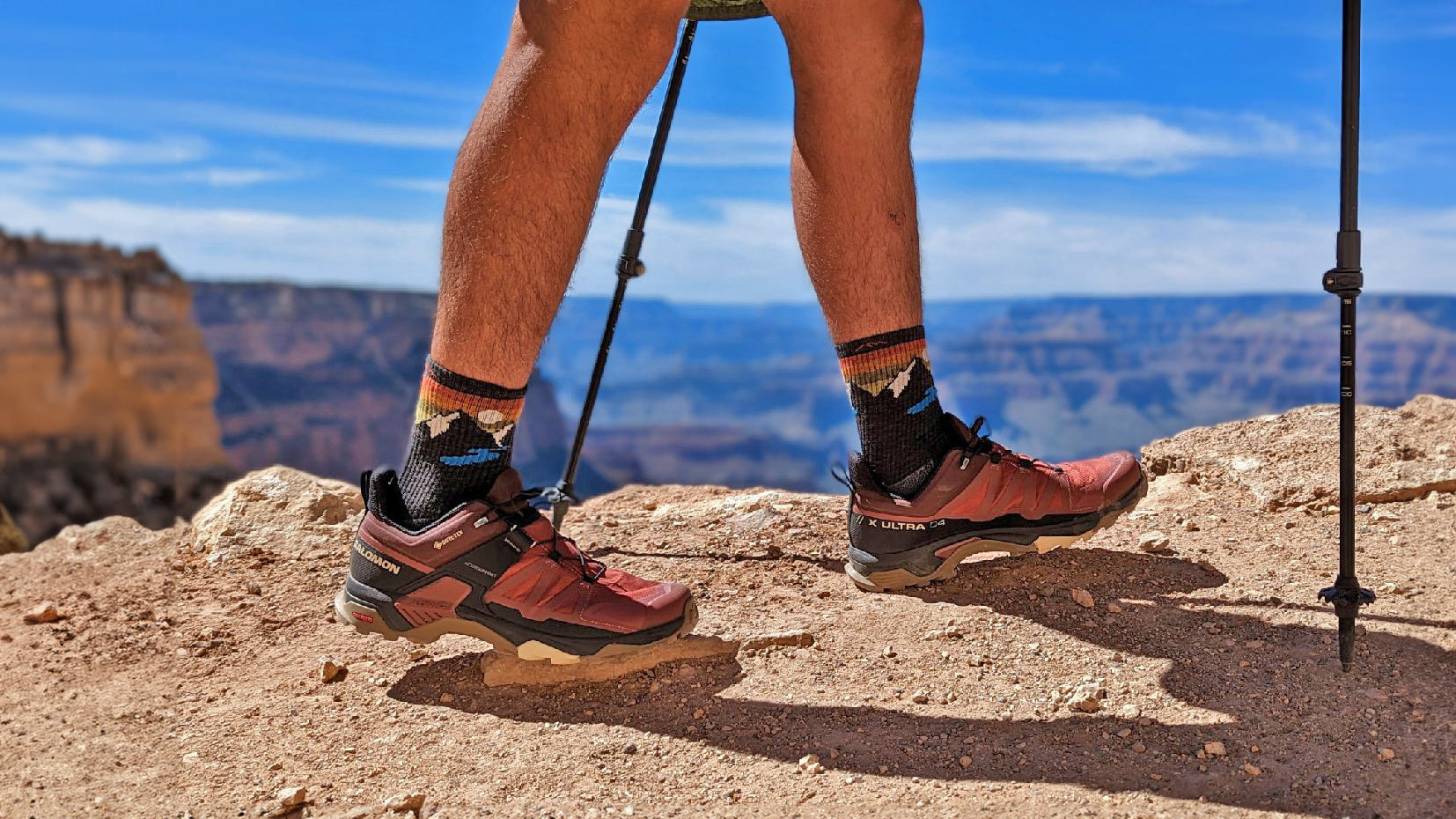
WET & MUDDY TERRAIN
Traversing damp, muck-filled trails requires not only waterproof uppers and slip-resistant outsoles but tread designs with self-cleaning lugs to shed the mess instead of taking it with you. To find out how to stay dry and safe while hiking in the rain, check out our 10 Tips For Hiking And Backpacking in the Rain Guide.
Medium-to-lightweight shoes with flexible soles will help you stick to slimy rock and move through the mire. Look for more features like a higher ankle height and a gusseted tongue to lock out moisture and debris. For wet, muddy terrain, we recommend:
- KEEN Targhee IV WP (Men’s / Women’s) – They are waterproof, and feature sloped lugs for fast movement and reliable walking on slick surfaces. The slightly flexible outsole shows these boots are made for mushy trails.
- Salomon Quest 4 GTX (Men’s / Women’s) – Thanks to the Contagrip outsole, supportive construction, and waterproof lining, the Quest 4 will keep you dry and comfortable while pushing through puddles.
- La Sportiva Spire GTX (Men’s / Women’s) – The Spire is the perfect blend of hiking boots and trail runners, offering all the reliability of a lug-heavy sole that sheds water and mud easily with a ventilated, tall mesh upper that keeps you nimble.
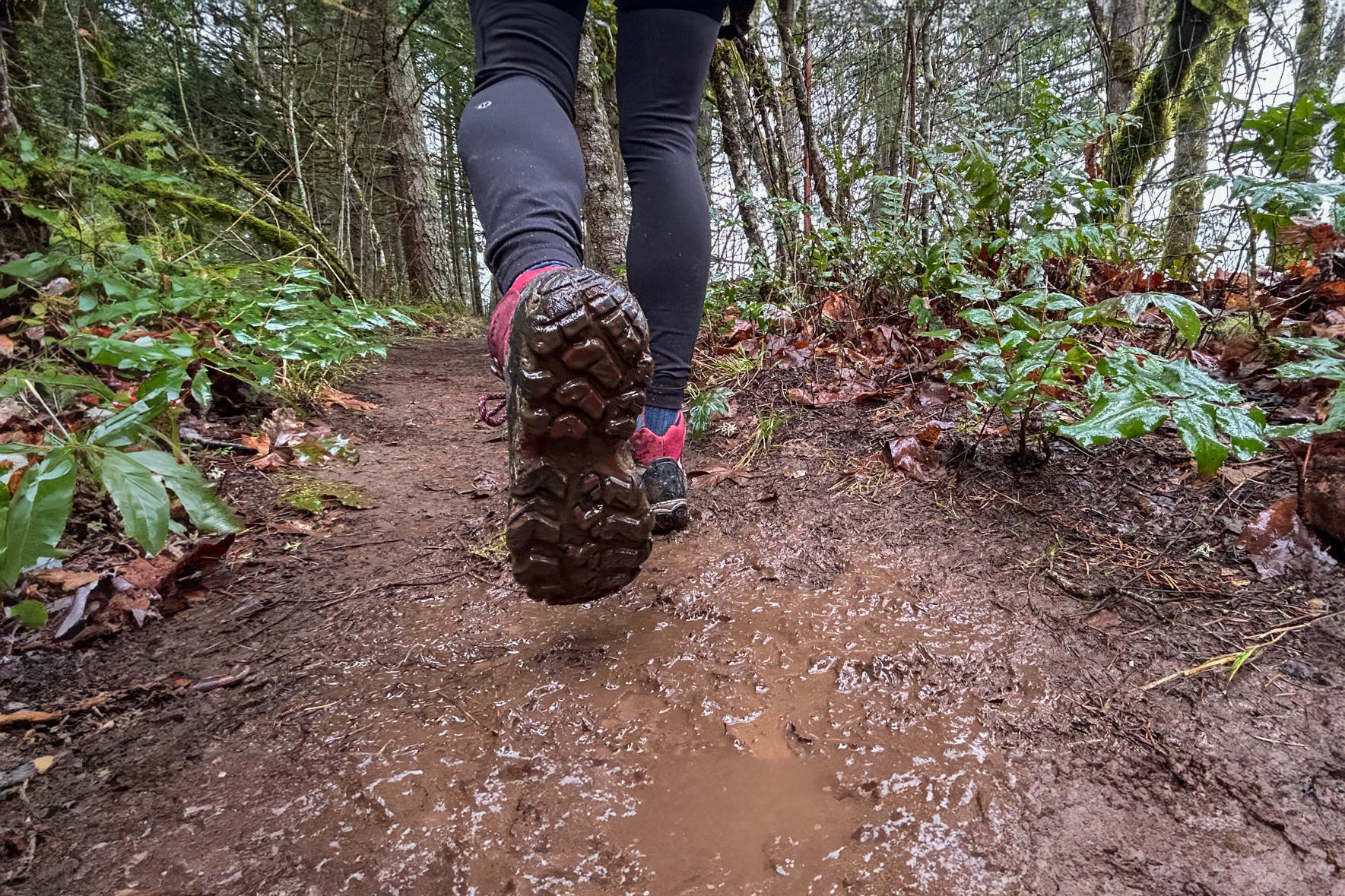
SNOWY TERRAIN
When you’re headed into the frozen tundra of winter, the first priority is insulated and waterproof boots with efficient traction – warm, dry feet are crucial. Stiff boots with insulated midsoles and aggressive, deep lug patterns are key to providing grip on snow and ice.
For especially snowy conditions, consider adding traction devices like microspikes to your winter kit. Check out our Best Traction Devices list for some of our favorites.
Additionally, look for boots that make your feet feel supported no matter how soft the ground is. For icy, snowy hikes, we recommend:
- Merrell Thermo Chill Mid (Women’s) – A fleece lining, stellar support, and a rigid sole will keep you warm for most winter activities.
- Columbia Fairbanks (Men’s) / Minx Shorty (Women’s) – With effective insulation, a waterproof but breathable layer, and comfort that extends past your ankles, these boots will ensure secure footing on winter trails or slippery sidewalks.
- Salomon X Ultra Mid Winter (Women’s) – We like the aggressive tread on this shoe. It can handle almost any winter hiking adventure. Plus, the great fit, lower price tag, and high quality are hard to beat.
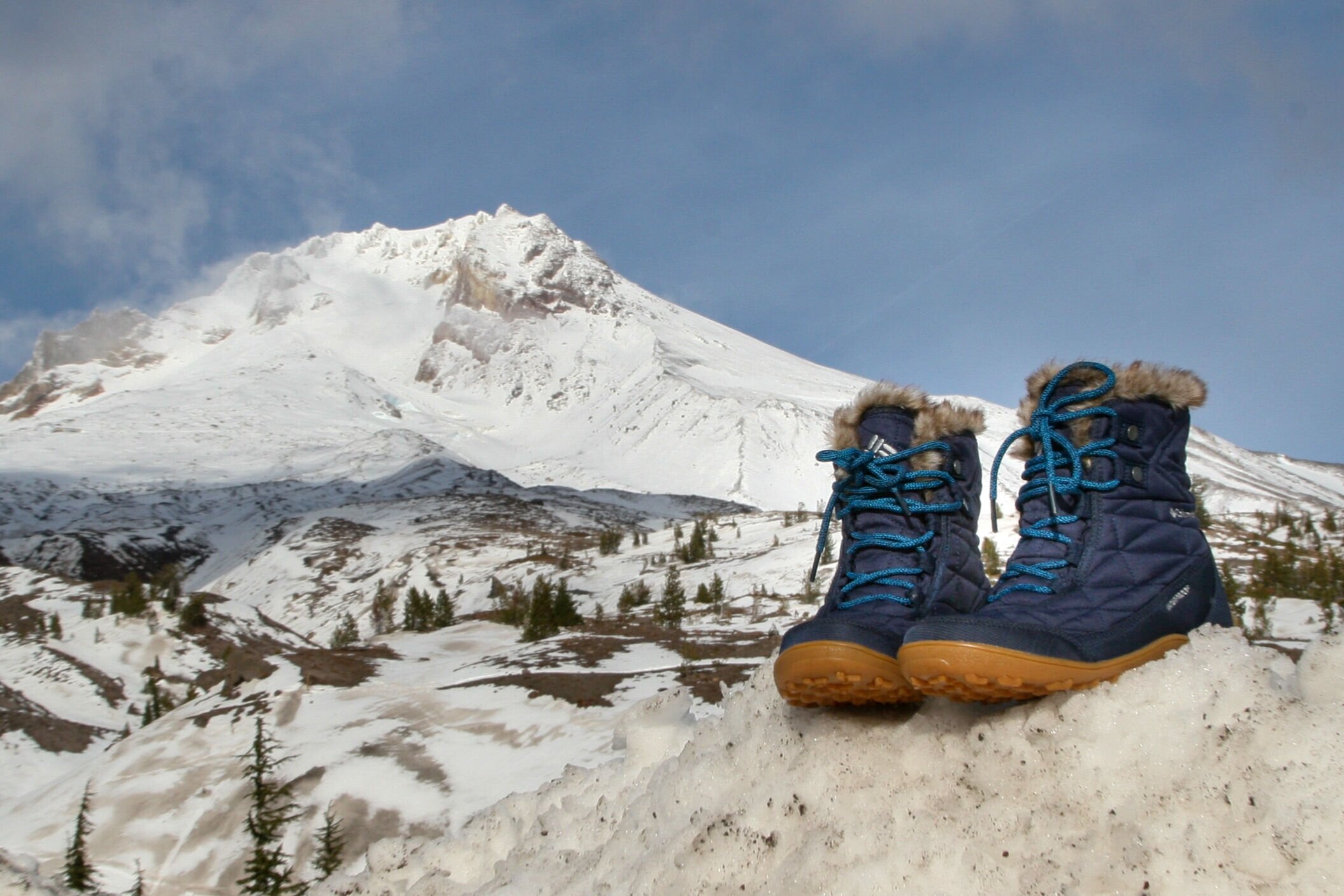
DESERT, SAND & ARID TERRAIN
The best footwear for toasty environments is built with lightweight materials to help with temperature management. Sandy, dry environments require softer, flexible outsoles durable enough to handle dirt, loose gravel, and big rocks. Look for soles with more foam content and less rubber composite to maximize ventilation. They should also offer a tread pattern that sheds debris easily.
Look for shoes with breathable uppers to maximize airflow when it’s hot. For sweaty, arid hikes, we recommend:
- HOKA Speedgoat 5 (Men’s / Women’s) – These are a top performer on our list of the best hiking shoes. The cushy midsole and super breathable materials, combined with their durable, mesh-free uppers make them a stellar and flexible fit for desert hikes.
- Topo Athletic Ultraventure 3 (Men’s / Women’s) – For long walks in high, dry temperatures, the Ultraventures are a strong lightweight hiking option with a wide toe box to truly let your feet breathe.
- Chaco Z/1 Classic and Chaco Z/Cloud (Men’s / Women’s) – Hiking in sandals has grown in popularity, and some hikers even prefer them for multi-day treks and big mileage days. Though this style of hiking isn’t for everyone, we agree that there are strong Pros and Cons to Backpacking in Sandals. But, if you want ultimate ventilation and don’t want to sacrifice support or durability, look no further than a pair of Chacos.
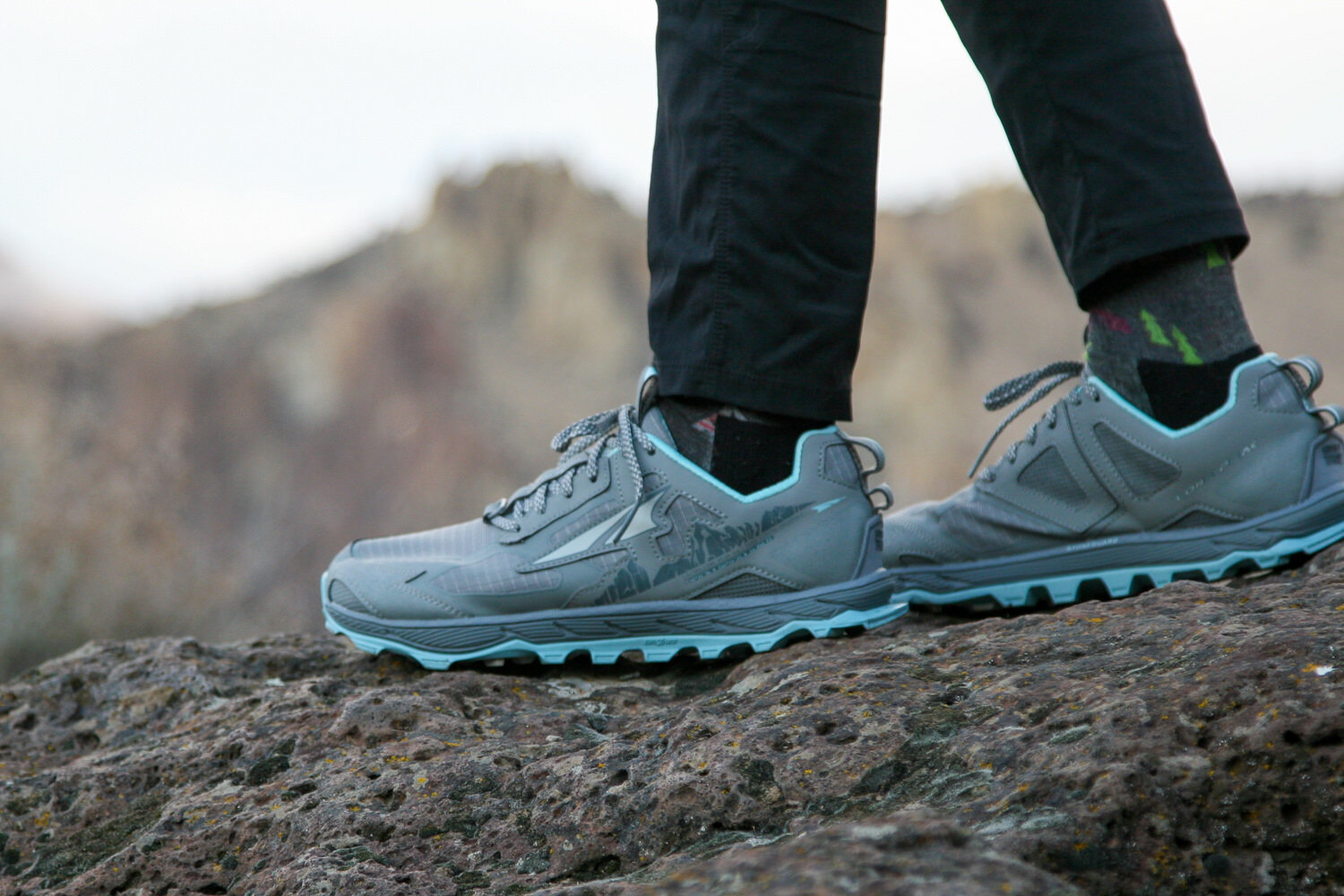
FORESTED TERRAIN
Whether it’s roots, rocks, uneven dirt, pokey plants, or steep river banks, the woods are full of obstacles. You’ll need comfortable, versatile hiking boots with medium to aggressive tread patterns. The midsoles can be soft to moderately stiff, as long as the outsole is grippy.
Look for additional protective features like waterproof uppers and ankle support. For hikes through the forest, we recommend:
- La Sportiva Nucleo High II GTX (Men’s / Women’s) – At barely 2.5 pounds, the Nucleo High II is a lightweight but beefy boot that can handle any challenges forest trails might present.
- Merrell Moab 3 (Men’s / Women’s) – Sure, these boots run heavier and bulkier than the above options, but they are incredibly comfortable, durable, and breathable. Sometimes, robust support and substantial cushioning are all you need for a pleasant hike through the backwoods.
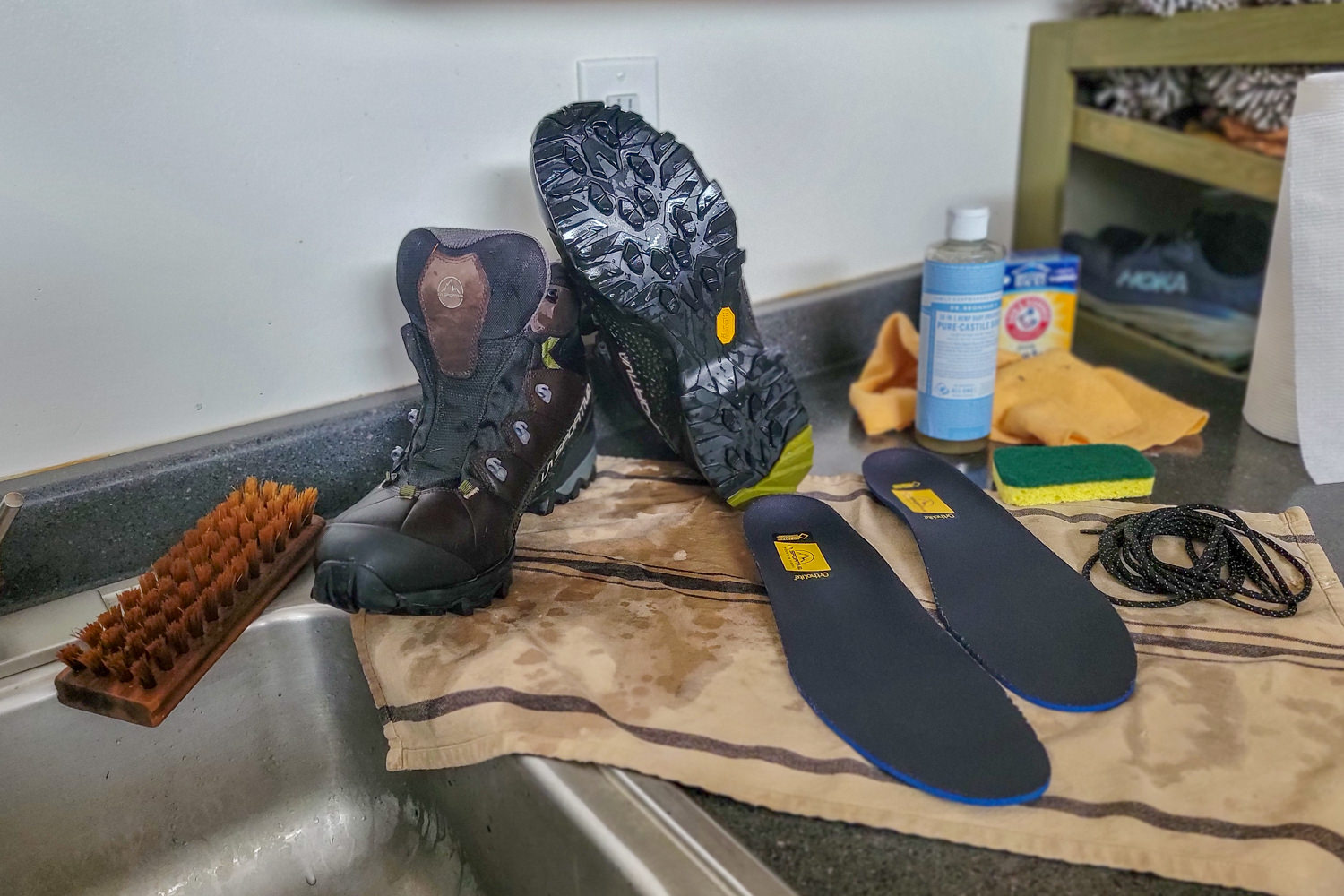
Tips for Maintaining Hiking Boots
CLEANING & MAINTENANCE
The biggest reason to keep your hiking shoes clean is to lengthen the life of your footwear. By regularly removing dirt and grime, you can also prevent bacteria buildup and prevent funky odors – no one likes stinky shoes in the house. A little scheduled maintenance for your favorite boots goes a long way to ensure they remain functional and comfy for your next hike.
- Damage control – About once a month, we recommend inspecting shoes and soles for signs of significant wear, damage, or separation from the uppers. We’ve found that even the most innocuous hike can cause unexpected damage to your shoes, and regular inspection can prevent further damage from roots and rocks. For holes and tears on and around the soles of the shoes, we recommend a long-lasting sealant gel like Gear Aid Aquaseal SR. For boot fabric in need of extra waterproofing, we recommend a repellent spray like Nikwax Fabric & Leather Proofing Spray. For especially worn tread, don’t replace, resole. Many brands offer fast, affordable, and impressive resoling services, a great option if the upper is still in good shape.
- Regular cleaning – Dirt, sand, and debris wedged into your hiking shoe can accumulate over time. These particles will eventually break down the material of the shoe and tread. We recommend cleaning your boots after every hike. For especially filthy cases, use a hose or strong water spray to douse the shoe and clear large messes. The rest of the time, a soft brush or cloth is all it takes to remove dirt, mud, and debris from the soles and upper of the shoe.
- Deep cleaning – We recommend deep cleaning your shoes once a month for heavy use during hiking season or once per season for occasional use. First, remove the insoles and laces, then scrub the soles and upper with warm water and a footwear-specific cleaning gel like Nikwax Footwear Cleaning Gel. Grangers Footwear Cleaning Kit also works well. Never use harsh chemicals or solvents since they can destroy the shoe materials and even dissolve adhesives. Air dry all the way before storing.
- Waterproofing – The upper of your waterproof boots will need to be refreshed periodically. Maintaining this external material is crucial to keep your favorite pair of boots healthy, strong, and functional. If you’re regularly using your boots, you may need to waterproof them multiple times in a season. For occasional use, you may find that additional waterproofing is only needed once a season. If your shoes are leather or suede, consider adding a quality leather conditioning option like Nikwax Liquid Conditioner For Leather. For both synthetic and leather options, a layer of waterproofing spray like Nikwax Fabric and Leather Waterproofing Spray can dramatically extend the life of your boots without affecting the aesthetic of the boot finish.
- Thorough drying – Drying is the easiest part: leave your boots in your house at room temperature. That’s it. Though a thorough wash will only take 10 to 20 minutes, there’s no rushing the drying process. You can stuff bunched paper towels into the boots to absorb additional moisture or set them up in front of a fan to keep the air moving, but we recommend budgeting 1 to 3 days for your shoes to completely dry out. Never use additional, direct heat sources like heaters or sunlight, since heat damage can wreak havoc on the hiking boot material.
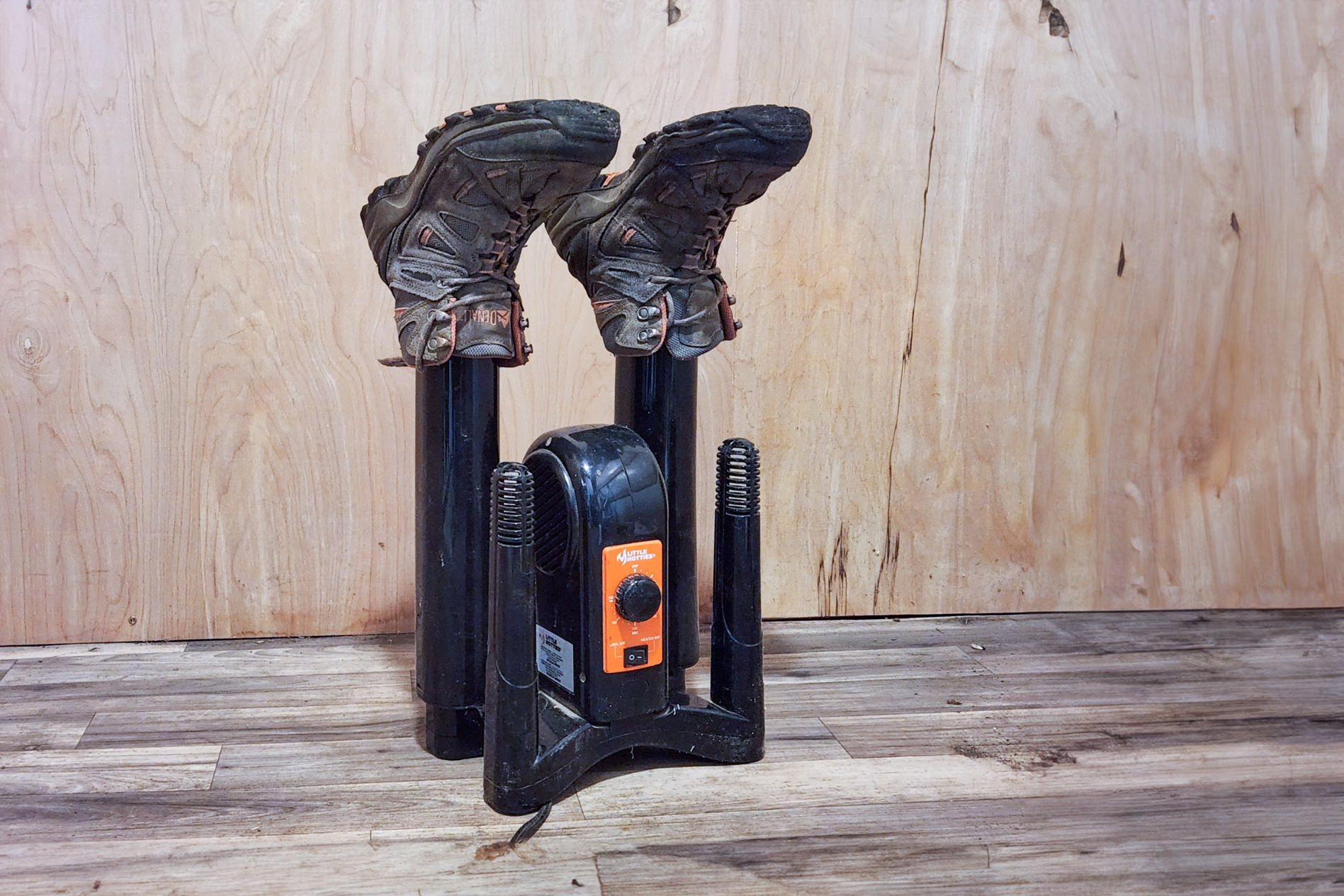
STORAGE TIPS
Hiking shoe storage is critical to keeping your favorite shoes crisp and ready for your next adventure.
- Cool and dry – Over time, direct sunlight and extreme temperatures will weaken adhesives, compromise fabrics, and deteriorate rubber compounds. Keep your hiking boots in a cool, dry place like a closet or shoe rack. If pests like rodents or insects are an issue where you live, consider storing shoes in a plastic bag for a little extra protection – but never a vacuum or compression sack.
- Compression is bad – Boots stored with heavy objects on top, or in a pile with other footwear, will lose their shape. Compression will eventually wreck the integrity of the materials. Your boot was likely compressed if it has a smashed or lopsided look, doesn’t return to its initial shape, or doesn’t fit how it once did. We recommend storing boots in an upright and open position and in a dedicated place in your house. If you’re concerned about your shoe losing shape, consider using inexpensive shoe shapers to prevent your favorite hikers from becoming misshapen during storage.
- Air is good – Moisture buildup is your hiking boots’ enemy. Avoid storing boots in damp garages, sheds, or crawlspaces. To maximize ventilation of the boot when not in use, remove insoles, loosen boot laces, and open the tongue so there’s airflow around the shoe.
Bottom Line
Choosing the right hiking boot sole is crucial when you’re shopping for your next hiking boot. The construction of the insole, midsole, and outsole materials work together and directly impact your comfort, safety, and overall experience while hiking.
Different terrains demand specific sole types. Pay attention to features like breathability, waterproofing, support, cushioning, lug pattern, and insulation based on where you’re going. Be sure to choose a hiking shoe from a reputable sole manufacturer that will give you the right grip and traction in different conditions.
Whether you’re tackling rocky trails, sandy routes, wet and muddy terrain, snowy peaks, or the deep woods, a shoe sole that helps you thrive while hiking isn’t just great for your body – it’s peace of mind.

